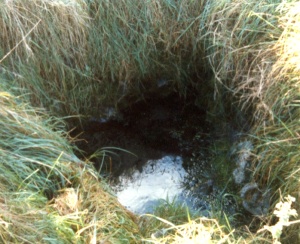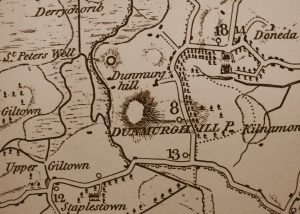St. Peter’s Well, Dunmurraghill
Published in Mona Newsletter, 2000
Dunmurraghill is a townland situated half a mile south of Donadea and is better known by its more modern name Greenhills’. This latter name is more than likely derived from the Irish translation of Dunmurraghill, Druim Uirchaille the ridge of the green wood.
The townland was a separate parish in the medieval period but is now in the Catholic parish of Staplestown/Cooleragh and the Church of Ireland parish of Clane and Donadea.
There are three ecclesiastical sites in the townland firstly, Dunmurraghill cemetery secondly, the Reliceen where an ancient Church was sited and thirdly St. Peters Holy Well.
The earliest mention of the townland comes from the Book of Armagh, which was completed in A.D. 807 and relates to St. Patrick’s visit to the area. This describes St. Patrick’s journey through Meath in about the year 455 when he travelled south to Kilglin, situated approximately one mile north of Kilcock which was at that time close to the boundary of Leinster. He then crossed into Leinster at a place identified as Killeighter where a Holy well bears his name. From this point he made his way to Dunmurraghill where he spent the night in the house of a chieftain. The site of this dwelling is almost certainly the ring fort that was situated in the Green Hills sand pit, which was demolished in 1912. A partial sloping curve may be all that survives of the ring fort. It is situated on the southern boundary of the sand pit approximately 5 meters from St. Peter’s well.
According to recent research, many Holy wells predate the coming of Christianity and may in fact have been sacred sites associated with pre-Christian religious activity. It is well known that St. Patrick and the early Christian missionaries did not destroy the pre-Christian religious sites but incorporated existing practices into Christian ceremonies. So assuming that St. Peters well was an important site at the time of St. Patrick’s visit then it was likely that he would have had a role in transforming the well to Christian use.
It is likely the well was dedicated to St. Peter at some time in its early history but the reason for this has not survived. However a number of suggestions may answer this question. One likelihood is that St. Patrick visited the site on the feast day of St. Peter on 29th June and gave it this Christian name, alternatively there may have been a pre-Christian religious activity associated with the well on that day and the early missionaries simply altered the practice to a Christian ceremony and linked it with the feast of St. Peter.
From the early Christian period an annual religious ceremony would take place at Holy wells. The ceremony was referred to as a ‘Pattern’ and this name was derived from the word patron. It was held on the feast day of the saint to whom the well was dedicated. This would take the form of pilgrims arriving at the site, drinking its water praying and walking clockwise around the well a number of times. Certain festivities would follow such as eating, drinking, singing and dancing, which were then followed by devotions.
Patricia Jackson writing in the Kildare archaeological journal refers to a holy well named St. Patricks well at Donadea. The source for this information came from the Department of Folklore in University College Dublin. This well was used by St. Patrick to baptize converts and is almost certainly St. Peters well as it is described as being situated at the bottom of the Green Hill. There was a hawthorn bush hanging over the well and stones surrounded it. There is also an interesting story concerning a woman who lived close to the well. It is said that she prayed at the well continually and voices would answer her.
A ‘Pattern’ may have taken place at St. Peters Well prior to the mid 1500s but by 1837 there was no knowledge of a Pattern at the well; however there was a record of a Pattern previously held in Donadea Church on St. Peters day. Donadea Church has always been referred to as St. Peters Church and the place name suggests definite links with St. Patrick. In fact all place names bearing the name Domnach as in Domhnach Dheá (Donadea) signifies a Church that was founded by St. Patrick on a Sunday. As the two sites are only one mile apart and share a common saint and feast day together with links to St. Patrick, it is likely the origins of both are closely interconnected, with the common patron, St. Peter possibly derived from the one source.
It was also recorded in the book of Armagh that St. Patrick founded a religious house at Dunmurraghill. This was probably the ancient Dunmurraghill Church that was situated between the summit of the hill and Donadea demesne wall. The wording in the book also indicated the Church was sited above the valley that contained one of the major roads in the country of the period. This road was known as the ‘Slighe Mor’. Also at that time there was a stone that was more than likely a marker stone situated on this road and referred to as ‘a stone of Patrick’. However this stone does not appear to have survived although according to local tradition a rock blessed by St. Patrick did exist in the townland.
It would appear the religious house St. Patrick founded became a small monastery, as a reference is made in the early Christian period to seven Bishops who were from Dunmurraghill and descended from a king of Leinster. Further evidence of this monastery comes from the annals of the four masters that record the death in 837 of Domhnall Mac Aedh who was referred to as the ‘Abbot’ of Dunmurraghill.
The Vikings from Dublin destroyed the Church in 1035 and it appears the religious centre declined from this period and never recovered.
In 1880 Dr. Michael Comerford wrote that the foundations of the Church were visible and situated in a planted field known as the Fox-covert field.
Lord Walter FitzGerald carried out research in 1912 and wrote that the old burial ground was then referred to as the Reliceen. He recorded that the last burial he heard of took place in 1832.
In 1915 the graveyard at Donadea was closed to general burials and a new cemetery replacing it was situated at Dunmurraghill. The site chosen for the new burial ground was very interesting, as it may have been sited on a possible entrance to the Reliceen burial ground. It may well be that some knowledge of the ecclesiastical importance of Dunmurraghill was a factor in choosing this site together with a desire to maintain links with an area associated with St. Patrick and connections to St. Peter.
St. Peters well is listed as a monument on the Office of Public Works sites and monuments record and is therefore recognised as a site of archaeological importance. It is unique as it is beside a ring fort in a townland with definite documentary evidence of a visit by St. Patrick. From its origin possibly in the pre-Christian period it has miraculously survived to the 21st century and remains today an important ecclesiastical site sacred to all Christians.
My thanks to Hermann Geissel for the Latin translation.
- Rev. Shearman, Loco Patriciana, p. 112.
- Rev. Michael Comerford, Comerfords Collections, (1883).
- Walter FitzGerald, Dunmurraghill, in J.K.A.S.Vol. vii, (1912), p.125–6. Catherine O’Donoghue, Holy Wells in 'Unity in Division', p 170.
- Patricia Jackson, The Holy Wells of County Kildare in J.K.A.S. Vol. xvi (1980), pp. 133–61.
- Ordnance Letters 1837. in J.K.A.S. Vol xii (1954), p. 434.
- P. W. Joyce, Irish Placenames.


